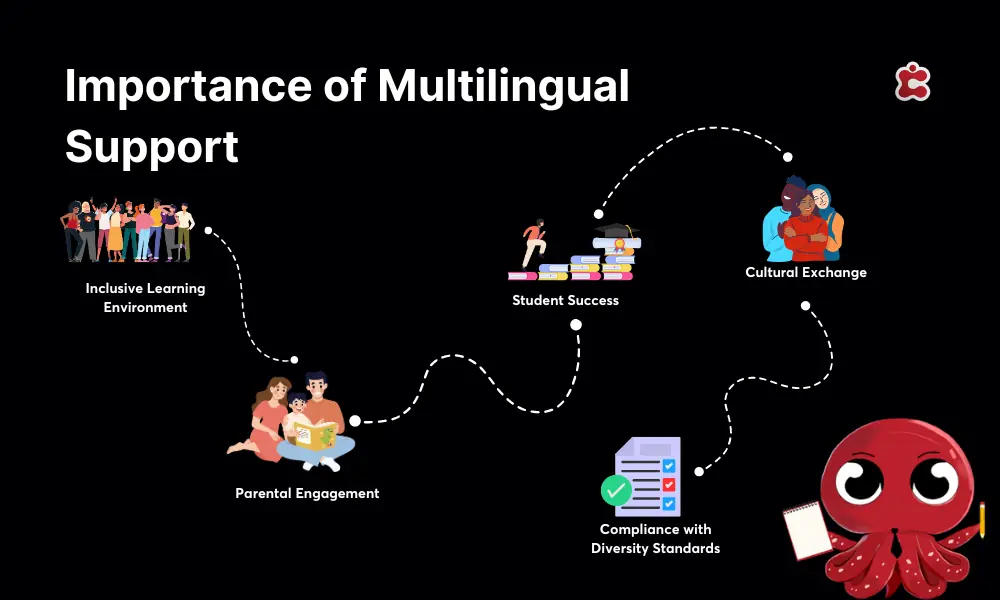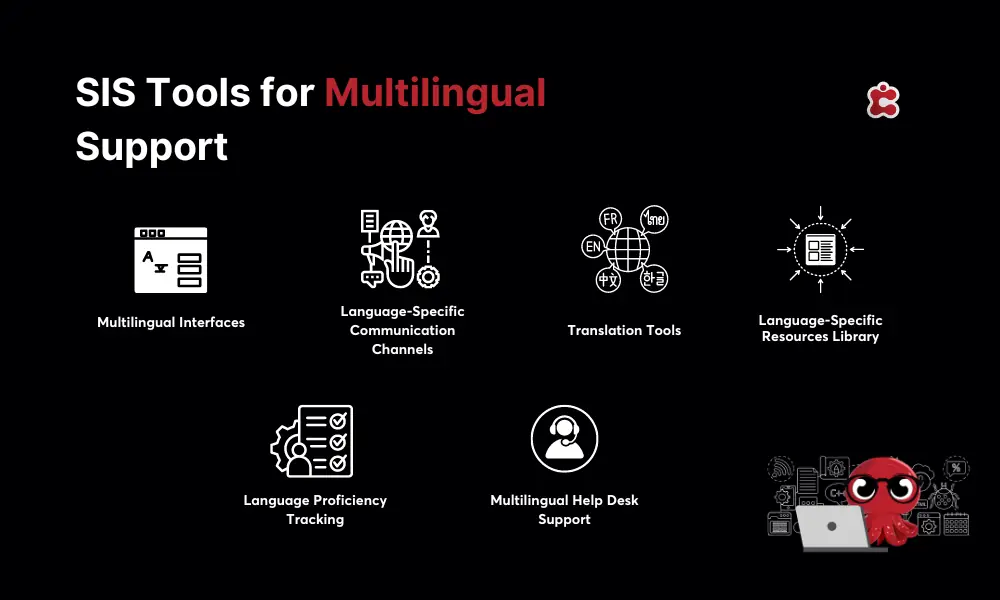Schools are the perfect place where diversity flourishes. Students come from different cultural and linguistic backgrounds converging under one roof. Thus effective communication serves as the lifeblood of collaboration and understanding. So, how do K12 schools ensure that every voice is heard and understood, regardless of linguistic barriers?
Student information Systems have become a popular solution for streamlining administrative tasks and tracking student progress. However, the true measure of an SIS’s effectiveness lies in its ability to transcend linguistic boundaries.
Imagine a scenario where a parent, fluent only in French, struggles to navigate through the English-only interface to access their child’s academic records. Such barriers can hinder parental involvement in their child’s education, leading to a sense of exclusion. By integrating multilingual support into SIS platforms, schools can dismantle these barriers and ensure that all members of the community feel equally valued.
Let’s explore how your K12 school can successfully implement multilingual support within your SIS platform to pave the way for inclusive communication.

Why We Need for Multilingual Support?
K12 schools today are microcosms of the globalized world we inhabit. Within a single classroom, one can encounter students speaking an array of languages, representing diverse ethnicities, nationalities, and backgrounds. This linguistic diversity is a testament to the richness of human experience but it also presents both opportunities and challenges for institutions.
Here are some key reasons why effective communication is essential:
Inclusive Learning Environment: Every student deserves equitable access to education, regardless of their linguistic background. Effective communication ensures that all students feel valued, respected, and included in the learning process.
Parental Engagement: Parents play a pivotal role in their children’s education. However, language barriers can hinder meaningful engagement between school and home. By promoting effective communication channels, schools can empower parents to actively participate in their children’s academic journey.
Student Success: Clear communication facilitates comprehension and understanding, enabling students to fully grasp academic concepts and instructions. When students can communicate effectively with teachers and peers, they are better equipped to succeed academically and socially.
Cultural Exchange: Language is intrinsically tied to culture. By embracing multilingualism, schools create opportunities for cultural exchange and enrichment, fostering a deeper understanding and appreciation of diverse perspectives.
Optimizing Your SIS for Multilingual Support
Using a Student Information System is a good start for communicating efficiently with parents and actively reaching out to students. With the integration of multilingual support, your SIS can become a powerful tool for fostering inclusive communication and engagement in linguistically diverse K-12 schools.
Tools and Features for Multilingual Support in SIS
1. Multilingual Interfaces: Ensure that your SIS offers user interfaces that are accessible in multiple languages. This allows students, parents, and faculty members to navigate the system comfortably in their preferred language.
2. Language-Specific Communication Channels: Implement communication tools within the SIS that support various languages. This enables seamless interactions among stakeholders, with features like multilingual messaging and announcements. Thereby, ensuring that important information reaches everyone in the school community.
3. Translation Tools: Incorporate built-in translation capabilities into your SIS to automatically translate text-based content into different languages. This simplifies communication processes. In addition, eliminates the need for manual translation and minimizes the risk of misinterpretation.
4. Language-Specific Resources: Provide access to language-specific resources within the SIS, such as instructional materials, forms, and documents tailored to the linguistic needs of diverse students and families. These resources support language acquisition and foster inclusivity within the educational environment.
5. Language Proficiency Tracking: Integrate features into the SIS to track students’ language proficiency levels. This allows educators to provide targeted support and resources to students who are learning a new language, ensuring their academic success and integration into the school community.
6. Cultural Calendar Integration: Incorporate a cultural calendar feature into the SIS, highlighting important events, holidays, and celebrations from various cultures and languages. This promotes cultural awareness and understanding among students, parents, and faculty members.
7. Multilingual Help Desk Support: Offer multilingual help desk support within the SIS, allowing users to receive assistance and troubleshooting in their preferred language. This ensures that language barriers do not hinder access to technical support and resources.
Customization Options within SIS for Linguistic Diversity
Customization options are essential for accommodating the unique linguistic and cultural characteristics of each school community. Admins should have the flexibility to configure the SIS to align with the languages spoken within the school district. This includes dialectal variations and minority languages. Customizable fields for student and parent information allow for the inclusion of language preferences. Now, schools can ensure that communications are delivered in the most appropriate language for each recipient.

Challenges in Implementing Multilingual Support
Having an SIS platform that can support multilingualism has a range of benefits. From fostering inclusivity to enhancing communication and engagement among students, parents, and faculty members who speak different languages, the advantages are endless. However, it doesn’t come without its own unique set of challenges.
One of the primary challenges in implementing multilingual support within SIS is overcoming language barriers. Diverse linguistic backgrounds among students, parents, and faculty members necessitate the provision of information in multiple languages. However, this can be logistically complex and resource-intensive, particularly for schools with limited resources.
Integrating multilingual support within existing SIS platforms can be technically challenging. This is particularly true if systems lack built-in support for multiple languages. Customization or integration of third-party translation tools may be necessary, adding complexity to implementation and potentially impacting system compatibility.
Ensuring compatibility and consistency of multilingual support across various devices and platforms presents additional technical hurdles. User interfaces, fonts, and text formatting may need to be optimized to accommodate different languages and devices effectively.
To overcome the challenges, schools can adopt a multifaceted approach that combines technological solutions, cultural sensitivity, and strategic resource allocation. Firstly, investing in robust translation tools and language localization features can streamline the process of translating information into multiple languages. Secondly, hiring multilingual staff members or partnering with language experts can provide valuable insights into cultural nuances and effective communication. Finally, allocating sufficient resources for regular system maintenance and updates. This will ensure that the SIS platform remains compatible with evolving language requirements and technological advancements. Thereby, sustaining optimal functionality and usability over time.
Classter’s Multilingual Support
Classter’s Student Information System goes beyond traditional management solutions by offering comprehensive multilingual support. This empowers K12 schools to bridge language barriers and foster inclusive environments. Through a range of key features and functionalities, Classter facilitates seamless communication and engagement among students, parents, and faculty members.
- Classter offers the flexibility to customize the platform’s terminology and interface in multiple languages. Administrators can easily configure the system to display menus, notifications, and communication channels in the preferred language of users, enhancing accessibility and user experience.
- Classter provides multilingual portals tailored to the diverse needs of students, parents, and faculty members. These portals offer language-specific interfaces, allowing users to navigate seamlessly.
- Classter promotes cultural sensitivity by accommodating diverse cultural practices and preferences within its platform. From calendar events to holiday notifications, the system acknowledges and respects cultural differences.
Don’t let language barriers hinder your educational journey. Schedule your demo today and embark on the path towards a more connected and culturally diverse learning environment with Classter. Let’s break down barriers and embrace diversity together.
FAQ’S
Multilingual support promotes inclusivity, enhances parental engagement, and promotes student success by breaking down language barriers and ensuring effective communication.
Multilingual support facilitates communication and collaboration among students from different cultural backgrounds, promoting cultural exchange, empathy, and a broader perspective of the world.
Classter stands out for its intuitive interface, customizable features, multilingual support, and commitment to fostering inclusive educational environments.

